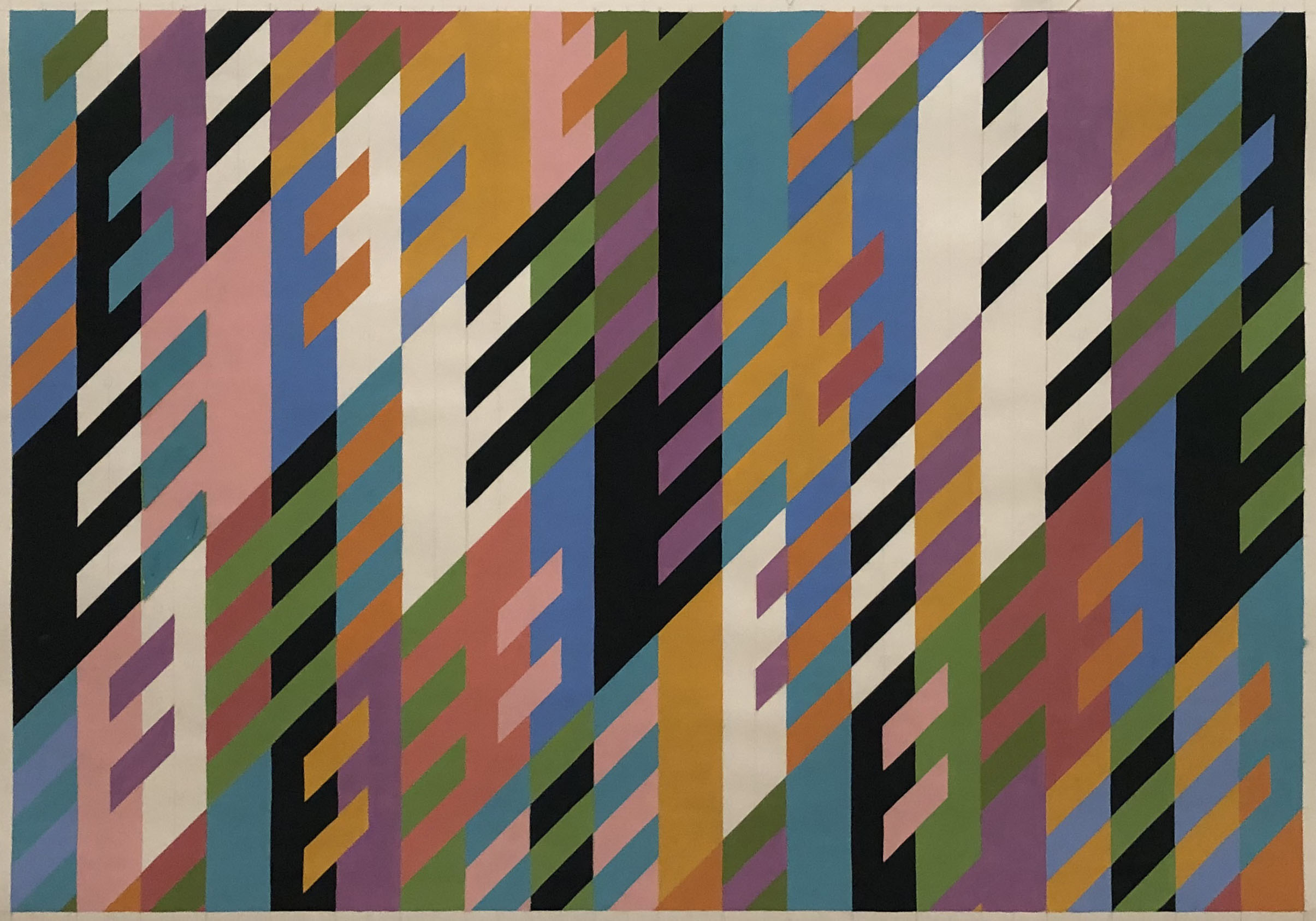 |
| Bridget Riley, Revision of March 1, 1988 |
The Hammer Museum's works on paper gallery has another compelling show. "Bridget Riley Drawings: From the Artist's Studio" is said to the be first museum show of the British artist's work (in any medium) on the West Coast. The Hammer gallery retains the room-within-a-room layout used by last fall's "Picasso Cut Papers." Like that exhibition, it's filled with revelations.
 |
| Bridget Riley, Blue Landscape (oil on canvas), 1959 |
One is the depth of Seurat's influence on Riley. As a student she copied several of Seurat's paintings. She also produced original "pointillist" works, represented here by Blue Landscape. In a way, the Seurat connection makes sense. Seurat drew on scientific theories of color perception to create paintings that (like Riley's) dazzle behind a certain emotional remove.
 |
| Bridget Riley, Study for 'Kiss,' 1961 |
Viewers are more likely to connect Riley to minimalism, and that isn't totally wrong. She tried a monochrome black painting and decided it was a failure. She bounced back with Kiss, a small drawing and then a full-size painting that she regarded a turning point. Kiss is much in the spirit of L.A.'s hard-edge abstraction. That may not be entirely coincidental. LACMA's 1959 exhibition of "Four Abstract Classicists" (meaning John McLaughlin, Lorser Feitelson, Frederick Hammersley, and Karl Benjamin) traveled to London and Belfast (but not New York!) in 1960.
 |
| Bridget Riley, Study for 'Blaze,' 1962 |
Within a couple of years Riley had devised the scintillating, black-and-white paintings that made her reputation. Two unmissable points of reference were the dazzle camouflage of the first World War (adopted as an artistic motif by Edward Wadsworth) and popular interest in perceptual illusions.
 |
| Bridget Riley, Study for 'Intake,' 1964 |
Riley's mature paintings are executed by studio assistants from her drawings or collages. The drawings are thus the definitive autograph versions, comparable to Rubens' oil sketches. The Hammer show includes hand-drawn originals of some of Riley's best-known paintings.
Riley appeared in a 1965 MoMA group show, "The Responsive Eye." It toured to several U.S. venues, including the Pasadena Art Museum. By then the term "Op Art" was in use, a play on "Pop Art." Of the core group of Op artists, only Riley has remained enduringly relevant.
 |
| Bridget Riley, 19 Greys Cool Ground, 1966 |
 |
| Bridget Riley, Egyptian Stripes with Revisions, 1983 |
 |
| Bridget Riley, July 1 "Bassacs," 1994 |
Likely many abstractionists, Riley describes her mission as realism, as uncovering unseen truths. A gallery label quotes her: "There is an eye at the end of my pencil, which tries, independently of my general-purpose eye, to penetrate a kind of obscuring veil or thickness."
"Bridget Riley Drawings: From the Artist's Studio" originated at the Art Institute of Chicago. It runs at the Hammer through May 28, 2023, and then travels to the Morgan Library & Museum, New York (June 23 to Oct. 8, 2023). Cynthia Burlingham, Jay Clarke, and Rachel Federman curated.
Across the street, a Westwood cafe has an Op Art pitch to the museum crowd.










Comments
Plus, something about that one part of Europe where she's from - separated by the English Channel - has incubated a lot of creative muscle for decades. Although other Europeans and Asians and Latinos (eg, Brazil), etc, too have been influencers in creative fields during the 20th century, it's the English-speaking parts of Europe and North America over the past 70 years that have somehow really stood out in the arts: In the visual, music, cinema, fashion.
It's now the 21st century and certain trends dating back over 50 years ago (such as where many of the most popular movies of the past 30 years have been produced) are still evident.
https://youtu.be/aqydTPDKQ44
But there's another paradox in the art-historical world: a wildly famous artist who never gets a monographic show. Case in point: Hugo van der Goes (Flemish, d. 1482). Next month, after only 540 years since his death, Berlin's Gemäldegalerie will host the first-ever one-man show of nearly all of Hugo's 34 surviving paintings and drawings.
My flight to Berlin leaves in April. Five days added to study Dresden. Sweet.